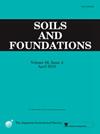Levee vulnerability assessment using an integrated unsaturated transient seepage model, sensitivity analysis, and fragility curves
IF 3.3
2区 工程技术
Q2 ENGINEERING, GEOLOGICAL
引用次数: 0
Abstract
The accelerated changes in climate resulting in more frequent and disruptive floods necessitate broader perspectives of levee vulnerability assessment. This paper aims to advance levee vulnerability curves using global sensitivity analysis to identify critical inputs for developing multi-variable fragilities. This analysis is efficient and effective for skewed data such as extreme precipitation. The study categorizes inputs into geometry, precipitation, and soil characteristics, generating 30,000 scenarios for analysis. A transient unsaturated seepage analysis is conducted to examine different failure modes such as piping, erosion, and overflow, as well as erosion initiation and enlargement time and locations for each scenario. Results show that, in addition to the initial upstream water level and precipitation characteristics, soil properties—such as gravel and clay content, along with water retention parameters—are crucial for developing fragility curves across different soil types. Additionally, comparing fragility curves for historical data and future precipitation projections highlights the importance of integrating these projections into levee risk analysis for the next 30 years. As a practical implication, these fragility curves are applied to calculate failure probabilities for a levee case study. This research would support the integration of levee vulnerability assessments with social factors and stakeholder perspectives which also increases the applicability of fragility functions in flood risk mitigation.
综合非饱和暂态渗流模型、敏感性分析和易损性曲线的堤坝易损性评价
气候的加速变化导致更频繁和破坏性的洪水,需要更广泛的视角来评估堤坝的脆弱性。本文旨在利用全局敏感性分析来推进堤防脆弱性曲线,以识别发展多变量脆弱性的关键输入。这种分析对于极端降水等偏斜数据是高效有效的。该研究将输入分类为几何形状、降水和土壤特征,生成了3万个场景供分析。通过暂态非饱和渗流分析,考察了管道、侵蚀和溢流等不同的破坏模式,以及每种情况下侵蚀的发生和扩大时间和位置。结果表明,除了初始上游水位和降水特征外,土壤性质(如砾石和粘土含量)以及保水参数对不同土壤类型的脆弱性曲线的形成至关重要。此外,比较历史数据和未来降水预测的脆弱性曲线,强调了将这些预测整合到未来30年堤坝风险分析中的重要性。作为实际应用,将这些脆性曲线应用于堤防的破坏概率计算。本研究将支持堤防脆弱性评价与社会因素和利益相关者的观点相结合,提高脆弱性函数在洪水风险缓解中的适用性。
本文章由计算机程序翻译,如有差异,请以英文原文为准。
求助全文
约1分钟内获得全文
求助全文
来源期刊

Soils and Foundations
工程技术-地球科学综合
CiteScore
6.40
自引率
8.10%
发文量
99
审稿时长
5 months
期刊介绍:
Soils and Foundations is one of the leading journals in the field of soil mechanics and geotechnical engineering. It is the official journal of the Japanese Geotechnical Society (JGS)., The journal publishes a variety of original research paper, technical reports, technical notes, as well as the state-of-the-art reports upon invitation by the Editor, in the fields of soil and rock mechanics, geotechnical engineering, and environmental geotechnics. Since the publication of Volume 1, No.1 issue in June 1960, Soils and Foundations will celebrate the 60th anniversary in the year of 2020.
Soils and Foundations welcomes theoretical as well as practical work associated with the aforementioned field(s). Case studies that describe the original and interdisciplinary work applicable to geotechnical engineering are particularly encouraged. Discussions to each of the published articles are also welcomed in order to provide an avenue in which opinions of peers may be fed back or exchanged. In providing latest expertise on a specific topic, one issue out of six per year on average was allocated to include selected papers from the International Symposia which were held in Japan as well as overseas.
 求助内容:
求助内容: 应助结果提醒方式:
应助结果提醒方式:


